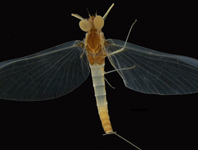Abstract
Symphoromyia clerci sp. nov. is described from the Eocene Baltic amber. Even if it has nearly all the characters of the extant species of Symphoromyia subgenus Symphoromyia, it differs from these flies in the short scape, as long as the pedicel (at least twice as long in extant taxa). This fossil is twice as large as those that were previously described from the same amber. These taxa need to be revised to verify their generic attribution. Symphoromyia clerci sp. nov. is the second fossil species attributable to this genus on the basis of ‘modern’ characters. The extant Symphoromyia are frequently hematophagous on mammals, suggesting a similar biology for the Eocene representatives of this genus.
References
Becker, T. (1900) Die Leptiden-Formen im Gebiete der Europaisch-Asiatischen und Mittelmeer-Fauna. Entomologisches Nachrichtenblatt, 26, 97–116, 176.
Bezzi, M. (1903) Katalog der Paläarktischen Dipteren. Wesselényi, Budapest, 396 pp.
https://doi.org/10.5962/bhl.title.5139
Cumming, J.M. & Wood, D.M. (2017) Adult morphology and terminology. In: Kirk-Spriggs, A.H. & Sinclair, B.J. (Eds.), Manual of Afrotropical Diptera. Vol. 1. Introductory chapters and keys to Diptera families. Suricata, Pretoria, 4, pp. 89–134.
Evenhuis, N.L. (1994) Catalogue of the fossil flies of the World (Insecta: Diptera). Backhuys Publishers, Leiden, 600 pp.
Evenhuis, N.L. (2014) Catalog of the fossil flies of the world (Insecta: Diptera). Version 2.0. Available from: http://hbs.bishopmuseum.org/fossilcat/ (accessed 30 January 2020)
Fabricius, J.C. (1775) Systema entomologiae, sistens insectorum classes, ordines, genera, species adiectis synonymis, locis, desriptionibus, observationibus. In Officina Libraria Kortii, Flensburg and Leipzig, 832 pp.
https://doi.org/10.5962/bhl.title.36510
Frauenfeld, G.R., von (1867) Zoologische Miscellen. Verhandlungen der Zoologisch-Botanischen Gesellschaft in Wien, 17, 425–502.
Frey, R. (1954) Studien über ostasiatische Dipteren III. Rhachiceridae, Rhagionidae, Hilaromorphidae. Notulae Entomologicae, 34, 1–25.
Hennig, W. (1967) Die sogenannten „niederen Brachycera“ im Baltischen Bernstein (Diptera: Xylophagidae, Xylomyidae, Rhagionidae, Tabanidae). Stuttgarter Beiträge zur Naturkunde, 174, 1–51.
Kerr, P.H. (2010) Phylogeny and classification of Rhagionidae, with implications for Tabanomorpha (Diptera: Brachycera). Zootaxa, 2592, 1–133.
Latreille, P.A. (1810) Considérations générales sur l’ordre naturel des animaux composant les classes des crustacés, des arachnides, et des insectes; avec un tableau méthodique de leurs genres, disposés en familles. F. Schoell, Paris, 444 pp.
https://doi.org/10.5962/bhl.title.39620
Linnaeus, C. von (1758) Systema Naturae per regna tria naturae secundum classes, ordines, genera, species cum characteribus, differentiis, synonymis, locis. Vol. 1. SEd. Decima Reformata. Laur. Salvii, Holmiae, 823 pp.
https://doi.org/10.5962/bhl.title.542
Macquart, J. (1826) s.n. In: Insectes Diptéres du nord de la France. Asiliques, Bombyliers, Xylotomes, Leptides, Vésiculeux, Stratiomydes, Xylophagites, Tabaniens. L. Danel, Lille, pp. 324–499.
https://doi.org/10.5962/bhl.title.148911
Meunier, F. (1892) Note sur les Leptidae de l’ambre. Bulletin de la Société Entomologique de France, 1892, lxxxiii.
Meunier, F. (1910) Monographie der Leptiden und der Phoriden des Bernsteins. Jahrbuch der Koeniglische Preussischen Geologische Landesanstalt, 28, 64–90.
Meunier, F. (1916) Sur quelques Diptères (Bombylidae, Leptidae, Dolichopodidae, Conopidae, Chironomidae) de l’ambre de la Baltique. Tijdschrift voor Entomologie, 59, 274–286.
Nel, A., Perreau, Z. & Doitteau, G. (2016) The oldest representative of the modern snipe fly genus Symphoromyia (Diptera: Rhagionidae). Zootaxa, 4196 (1), 144–150.
https://doi.org/10.11646/zootaxa.4196.1.9
Paramonov, S.J. (1936) Zur Entomofauna der Bernsteins [On the entomofauna of ambers.] Trudy Instituta Zoologii Akademiia nauk SSSR Kiev, 18, 53–64.
Turner, W.J. (1974) A revision of the genus Symphoromyia Frauenfeld (Diptera: Rhagionidae). I. Introduction, subgenera and species-groups, review of biology. The Canadian Entomologist, 106, 851–868.
https://doi.org/10.4039/Ent106851-8
White, A. (1914) The Diptera Brachycera of Tasmania. Part I. Families Leptidae, Stratiomyidae, Nemestrinidae and Cyrtidae. Papers and Proceedings of the Royal Society of Tasmania, 1914, 35–74.
https://doi.org/10.5962/bhl.part.19950
Zetterstedt, J.W. (1842) Diptera Scandinaviae. Disposita et descripta. Vol. 1. Officina Lundbergiana, Lund, 410 pp.


